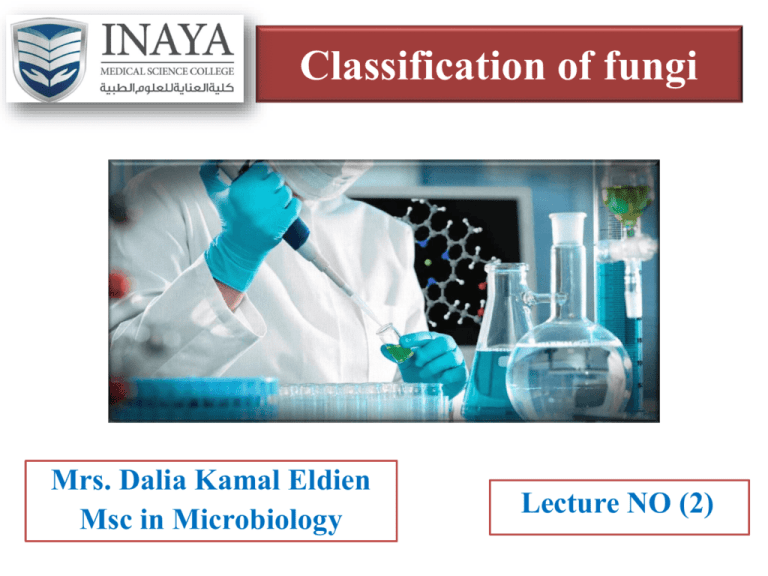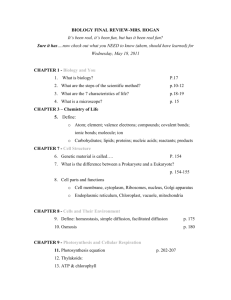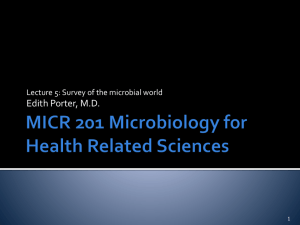
Classification of fungi
Mrs. Dalia Kamal Eldien
Msc in Microbiology
Lecture NO (2)
Objectives
Classification of fungi according to method of
reproduction & type of hyphae
Identification of the different classes of fungi
o Zygomycetes (phycomycetes)
o Ascomycetes
o Basidiomycetes
o Deuteromycetes
Classification of fungi
There are many ways for fungi classification, but the most
practical approaches based on:
Method of reproduction
Type of hyphae
Basing on those criteria they classify the fungi in to four
groups
o Zygomycetes (phycomycetes)
o Ascomycetes
o Basidiomycetes
o Deuteromycetes (Fungi imperfecti)
Zygomycetes
(phycomycetes)
Scientific classification
Kingdom: Fungi
Phylum: Zygomycota
Class: Zygomycetes
Zygomycetes (phycomycetes)
Commonly known as bread moulds
Zygomycetes are fast growing
Hyphae are aseptate
Reproduce sexual and asexual .
Asexual reproduction produce the sporangiospores, found
within sac like structure known as sporangia, sporangia are
borne on special hyphae called sporangiophore.
This endogenous process of spore formation within a sac is
known as Sporogenesis.
Zygomycetes under light
microscope
Identify the different parts?
Zygomycetes (phycomycetes)
Sexual reproduction involves producing a thick-walled
spore called a zygospore.
Example: Rhizopus, Mucor, Rhizomucor
ASCOMYCETES
Scientific classification
Kingdom: Fungi
Subkingdom:Dikarya
Phylum: Ascomycota
Class : Ascomycetes
Ascomycetes
The Hyphae of ascomycetes are septate with simple septal
pores
Reproduce sexual and asexual .
Asexual reproduction produce the conidia.
Conidia arise by budding of conidiogenous hyphae
Conidia are borne on specialized structures called
conidiophore (hyphae that bear conidia)
Asexual reproduction of
ascomycetes
Conidia of ascomycetes
Sexual reproduction is by the formation of endogenous
ascospores, are the largest sexual spore usually are eight
in number, present in an ascus sac, group of asci found in
ascocarp.
Sexual reproduction of
ascomycetes
1-Two gametangia arise on
adjacent cells and nuclei migrate
2-The female portion usually enlarges
and gametangia fuse. The fusion cell
enlarges into a sac
3-Meiosis takes place to
produce many nuclei
Fungus with Ascospores
(8 in number)
BASIDIOMYCETES
Scientific classification
Kingdom: Fungi
Subkingdom:Dikarya
Phylum: Basidiomycota
Class: Basidomycetes
Basidomycetes
Less medically important group
Have septated hyphe and reproduce sexually only
The sexual spore known as basidospore found in the tip of
hyphe typically, four on a basidium
Example: Mushrooms
Sexual reproduction of
basidomycetes
DEUTEROMYCETES
Deuteromycetes
Also name as Fungi imperfecti or imperfect fungi
Are the most medically important group
Have septated hyphe
Reproduce sexually and asexually, but mostly asexually,
result in formation of 3 types of spore: Thallospore
Conidiospore
Sporingiospore
Thallospore:are formed with in the hyphe, are two types
a) Arthrospore: by fragmentation of the terminal part of hyphe,
seen in pathological specimen not culture
b) Chlamydospore: formed by migration of content of two
adjacent cells
Arthrospore
Chlamydospore
Conidiophore
Conidia are asexual spore, important in identification of some
fungi, have different shape, size & arrangement:
a) Macroconidia: large& multicellular
b) Microconidia: small& unicellular
Sporingiospore
Similar to zygomcytes but the hypha is septated
Pathogenesis of fungi
Most fungi are saprophytic or parasitic to plants and are
adapted to their natural environment.
Infection in humans is a chance event, occurring only
when conditions are favorable.
Except for few fungi such as the Dimorphic fungi that
cause systemic mycoses and Dermatophytes, which are
primary pathogens, the rest are only opportunistic
pathogens.
Fungal Diseases (Mycoses)
Mycosis is the infection cause by fungi, classify according to
the tissue levels of infection to:
1. Superficial mycoses are limited to the outermost layers of
the skin
I. Superficial phaeohyphomycosis
II. Tinea versicolor
III. Black piedra
IV. White piedra
2- Cutaneous mycoses extend deeper into the epidermis, and
also include invasive hair and nail disease
I. Dermatophytosis
3- Subcutaneous mycoses involve the dermis, subcutaneous
tissues, muscle and fascia.
I. Chromoblastomycosis
II. Rhinosporidiasis
III. Mycetoma
4- Systemic (deep) mycoses due to primary pathogens
originate primarily in the lungs and may spread to many
organ systems, In general primary pathogens that cause
systemic mycoses are dimorphic.
I. Blastomycosis
II. Histoplasmosis
5- Opportunistic mycoses Systemic mycoses due to
opportunistic pathogens are infections of patients with
immune deficiencies
I. Candidiasis
II. Aspergillosis
Factors predispose fungal infection
o
o
o
o
o
o
o
o
o
o
Prolonged antibiotic therapy
Underlying disease (HIV infection, cancer, diabetes, etc.)
Age
Surgical procedures
Immunosuppressive drugs
Irradiation therapy
Indwelling catheters
Obesity
Drug addiction
Organ transplants





